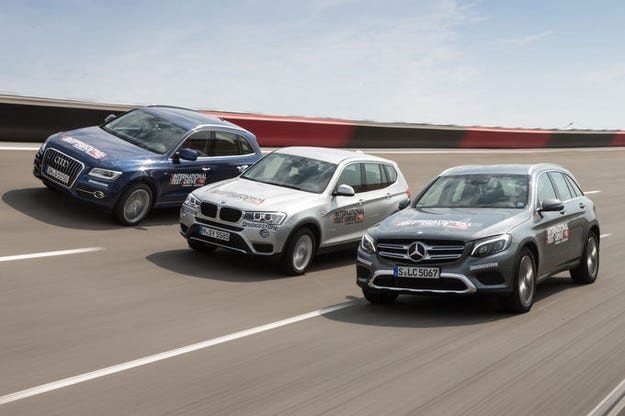
Audi Q5, BMW X3, Mercedes GLC: complete change
Content

The sharp edges of the GLK are followed by the rounded shape of the debutant GLC, which faces traditional competition. Audi Q5 and BMW X3.
The proximity of the European test center Bridgestone to the Eternal City is a reason for interesting associations... In the group of editors-in-chief of the auto motor und sport family from all over the world, we are a bit like a meeting of cardinals when a new pope is elected. For two long and hot days, representatives from Asia, Europe and South America subjected candidates to severe tests under the scorching Italian sun, and in the evening we thought and argued for a long time about the qualities and shortcomings of each of them.
Of course, in this case, we are not talking about broadcasting the next governor of St. Peter, but about indicating the best and worthy performer of the much more trivial, but far from difficult role of a practical, dynamic and economical companion in family travel and busy everyday life. ... And although there is almost complete unanimity on the question of the versatility of modern SUVs for successfully solving these problems, significant differences are quickly revealed in the opinions of individual candidates and individual tastes are highlighted. Some colleagues advocate the exceptional comfort of the new. Mercedes GLC, while another large group favors the dynamic behavior of the BMW X3. However, in the end, the winner is determined not by tastes or positive results in individual disciplines, but by an objective assessment of results in all disciplines, which indicates the level of the overall package of qualities.
Audi Q5 is a stable player
While the Q2008, which debuted in Year 5, plays a kind of patriarch in this comparison, the Audi model comes across as exceptionally balanced and competent in testing. In terms of interior space and a sense of spaciousness in the cabin, the Ingolstadt definitely surpasses its younger competitors and is the only one that offers additional options for separate longitudinal displacement (100 mm) and rear seat backrest angle adjustment. and the ability to fold the backrest next to the driver. On the other hand, the Q5 shows weaknesses in the ergonomics of some functions, an incomplete set of electronic driver assistance systems and a definitely atypical level of materials used in the interior for Audi. There is no doubt that all this will change dramatically when the model changes next year, but so far the situation is like that.
Until the next generation, no change to the most powerful 190hp 400-liter TDI. not expected. and a maximum torque of 5 Nm, which transmits traction to the four wheels via a seven-speed dual-clutch transmission. The turbo diesel does not impress with its special temperament, but when assessing the dynamics, both the Q1933's own weight of XNUMX kilograms and the slow response, noticeable pauses and the lack of a sporty zest in the S tronic in automatic mode should be taken into account.
This behavior of the powertrain contrasts somewhat with the dynamic appearance of the test car with the optional S Line sports package, 20-inch wheels with wide tires and suspension with adaptive dampers and five adjustment modes - from “comfort” to “individual”. All this helps the Q5 to pass the tests of the polygon and corners of the second-class sections of the road with unobtrusive speed, palpable safety and good comfort even on poor quality surfaces. All the time the behavior is pleasantly neutral, with direct reactions and no major body deviations. One could wish for a little better steering feedback, more willingness to forego driving along longitudinal paths on asphalt, a little less aerodynamic noise around the large exterior mirrors, and more comfort when going over bumps. However, in general, the Audi model does not have any serious drawbacks, and its main advantages are an autonomous range of about 1000 kilometers and excellent, very stable brakes.
BMW X3 – dynamic rival
The X3's braking distance is 100 km / h two meters longer than the Q5, and at 160 km / h the difference increases to an impressive eight meters. However, the drive to move forward is as typical of the Bavarian company as the X3's palpable drive for a dedicated rider with a conscious attachment to dynamics. With agility and direct, precise steering, the model follows the set course precisely and steadily, forcing the driver to take the next turn even more accurately and faster than the last. A significant contribution to all this is the emphasis on the rear axle wheels of the dual xDrive transmission, which prefers to direct most of the engine torque in that direction.
However, full fusion with the car is hampered by the very high position of the front seats, in which the optionally offered sports version can be too narrow for larger drivers. The position of the rear passengers is contrasting - low, with noticeably bent knees and hard hitting suspension, which, despite the additionally proposed system with adaptive dampers, practically does not absorb all the shocks when driving on uneven surfaces. In addition, the X3's seating space and cabin width are a bit more limited than the competition, but the Bavarian is trying to make up for the clear ergonomic concept and logical menus of the centralized iDrive system.
Although the test values and the maximum power and torque of the 1837-liter diesel are on par with the Audi TDI, the BMW model (not least because of the fast and precise operation of the eight-speed automatic transmission). transmission) leaves a more dynamic overall impression. Not so positive is the assessment of the rough tone of the four-cylinder machine, which showed the greatest appetite in the test despite the lowest weight (3 kg) that had to be faced. As a result, the X5 managed to rise to the top in the disciplines of road behavior and cost, but in the overall standings it fell slightly behind the QXNUMX.
Mercedes GLC - universal fighter
The serious ambitions of the new GLC are evident in the price - the 250 d 4Matic is significantly more expensive than the competition, and the addition of the usual items of equipment for this class, such as metallic paint, seat heating, parking system, navigation, infotainment system and much more. electronic driver assistance systems make life even more impressive from a financial point of view. On the other hand, the standard equipment of the model offers the most numerous safety measures in the test, complemented by cruise control, dual-zone air conditioning and partial electric seat adjustment. Only a Mercedes model can offer the option of ordering a serious off-road package with hill-descent function, five cross-country driving modes and underbody protection, and an optional air suspension system, which he also had a trial copy with.
The latter investment is definitely worth it, because the adaptive pneumatic elements gently and calmly absorb even large bumps in the road without worrying about a serious payload (maximum 559 kg) or even a tougher driving style. Comfortable seats, very good aerodynamic noise and chassis characteristics complete an almost flawless picture, which is a huge plus in terms of comfort for the GLC, both compared to its predecessor and compared to its two quality rivals. test.
Even the slightly gruff character of the 2,1-liter diesel unit in other models is presented here in a rather reserved acoustics and very difficult to distinguish from a gasoline engine. In addition, the 250 d engine offers a measurable 14 hp advantage. and 100 Nm ahead of its competitors, pulls forward with accentuated determination and at the same time manages to leave the impression of a complete lack of tension. At the same time, the new nine-speed automatic transmission offers precise gears quickly, but without undue rush, and small, almost imperceptible steps in the engine torque curve help the four-cylinder biturbo engine make the best use of its optimal revs. This has a positive effect on fuel consumption, which in tests averages 7,8 l / 100 km and even with a small serial tank (50 l) allows it to run a decent 600 km autonomously. However, we are still of the opinion that the 66-liter version should be part of the GLC's standard equipment.
The less sporty ambition of the road and the soft steering character, on the other hand, go well with the comfortable overall character of the GLC and cannot be considered negative, especially when you consider that neither the accuracy of the trajectory nor road safety are affected. these functions. The fact that the 12cm body now offers adequate interior space for the competition, and the quality of the interior definitely surpasses it, underscores Mercedes' commitment to making the most expensive but also the best deal in its class. Despite some redundant or broken styling elements, such as the chrome exhaust caps on the rear apron, the GLC comes out of this comparison as a well deserved and clear winner. On the other hand, everything else should surprise us, given his five- and seven-year-old direct rivals.
Text: Miroslav Nikolov
Photo: Hans-Dieter Zeifert
Evaluation
Audi Q5 2.0 TDI – 420 points
With the exception of excellent brakes, the Q5 scores points not for individual peak performance, but for excellent overall balance. At the same time, the combination of engine and transmission is relatively more cumbersome, and driver assistance electronics are not the last word in this area.
BMW X3 xDrive20d – 415 points
The dynamics expected by the Bavarian brand are present - at least as far as the behavior of the X3 on the road is concerned. Against this background, one could put up with a stiff suspension setup and engine noise, but not with slow acceleration. The price is reasonable, but the equipment is not very rich.
Mercedes GLC 250 d 4matic – 436 points
The GLC's high performance in areas such as comfort and safety came as no surprise, but the new model's powertrain leadership turned out to be an unexpected and very strong advantage - a quiet and economical diesel engine combined with an excellent nine-speed gearbox finally tipped the scales to victory for Mercedes. .
technical details
| Listen Q5 2.0 TDI | BMW X3 xDrive20d | Mercedes GLC 250 d 4matic | |
|---|---|---|---|
| Working volume | 1968 cm³ | 1995 cm³ | 2143 cm³ |
| Power | 190 k.s. (140 kW) at 3800 rpm | 190 k.s. (139 kW) at 4000 rpm | 204 k.s. (150 kW) at 3800 rpm |
| Maximum torque | 400 Nm at 1750 rpm | 400 Nm at 1750 rpm | 500 Nm at 1600 rpm |
| Acceleration 0-100 km / h | 9,1 with | 8,8 with | 8,1 with |
| Braking distances at a speed of 100 km / h | 35,2 m | 37,4 m | 37,0 m |
| full speed | 210 km / h | 210 km / h | 222 km / h |
| Average consumption fuel in the test | 7,9 l | 8.2 l | 7.8 l |
| Base Price | 44 500 Euro | 44 050 Euro | 48 731 Euro |

One comment
Igor
Funny typo "Although Q2008 debuted in '5".
Thanks for the article, interesting! You could also add the cost of content for a complete picture.